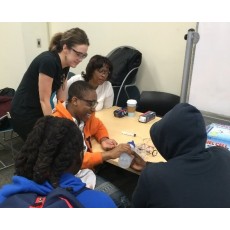Fuel Cell Car Demonstration and Competition
About The Fuel Cell Car Competition

The first Columbia Chemical Engineering Fuel Cell Car Demonstration and Competition was planned, developed, and executed in order to inspire and educate young people about chemical engineering. This hands-on experience was modeled after the American Institute of Chemical Engineers (AIChE) ChemE Car Competition X7 Fuel Cell Car from Thames and Kosmos. This competition was part of a Science Technology Engineering and Math (STEM) outreach event organized by the Chemical Engineering Graduate Organization (ChEGO) and Dr. Robert G. Bozic, Lieutenant Colonel U.S. Army(Retired) in the Columbia University Department of Chemical Engineering. The purpose of this event was to enable high school student involvement in a competitive chemical engineering experience built on the foundations of the American Institute of Chemical Engineers (AIChE) ChemE Car competition, with easily manageable logistics and short preparation times, while meeting all safely requirements. In order to meet these challenges in a time constrained environment, ten of the Thames and Kosmos X7 Fuel Cell Cars affectionately named after the Columbia themes (Roar-ee, Pride, Lion, Lioness, Cub, and Ivy) and electrochemical engineering themes (ChemE, Electro, Voltaic, and Galvanic) were used in graduate student led competition. Over 30 students and visitors were introduced to this unique chemical engineering competition concept and encouraged to participate at increasing levels of complexity.
Two levels of competition are available, “Speed Racer” and “Chemical Engineer”. The “Speed Racer” level includes brief instruction on risk assessment, chemical safety, principles of the mass and energy balance, and emphasis on the chemical engineering nature of the competition as well as emphasis on the engineer problem solving approach. This level allows for the student to reach the trial run stage within minutes. The “Chemical Engineer” level emphasizes the basics seen in the “Speed Racer” level as well as error analysis, computer aided design using ASPEN, efficiency calculations, and a more deliberate approach to understanding effects of error on the equations used to estimate the volume of hydrogen gas required to travel the desired distance. The time scales would be in hours, for a thorough treatment of the areas of emphasis in the “Chemical Engineer” level. The essence of the competition is to determine the volume required in order to make the X7 Fuel Cell Car move the distance desired and to achieve success by being the team that gets the car as closest to the finish line as possible without touching the finish line or going over it with any part of the car. [3] Presented with this chemical engineering problem, the student competitors with the assistance of a graduate student leaders are fully engaged in a chemical engineering competition that may be executed indoors or out. Based on inclement weather decisions associated with outdoor activity, generally the competition has been conducted indoors. The purpose of this article is to outline the event as a means for others to replicate the type of Chemical Engineering STEM Outreach conducted at Columbia University Department of Chemical Engineering. The event is broken down into phases, Planning and Resourcing, Instructor Preparation and Rehearsals, ChemE Fuel Cell Car Demonstration and Competition, Recovery Operations, and After Action Review. Some conclusions are presented as well.

For more information on the Fuel Cell Car Competition, visit: http://fuelcellstore.com/blog-section/columbia-fuel-cell-car-competition.
